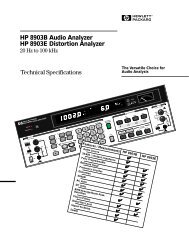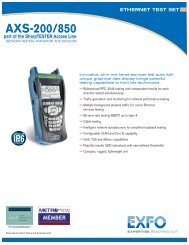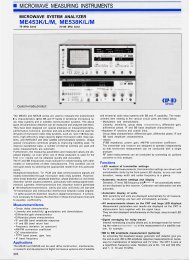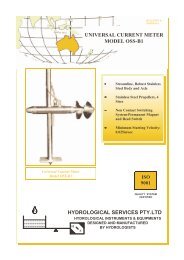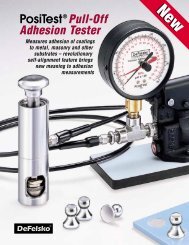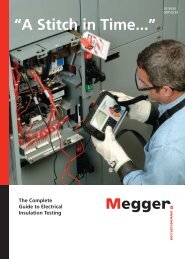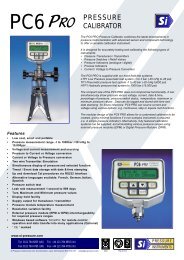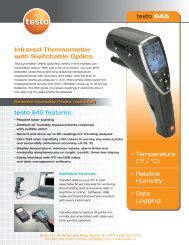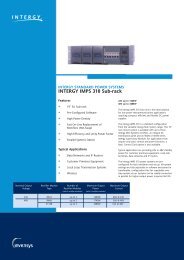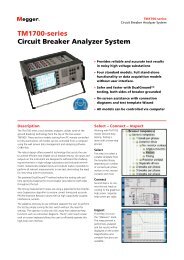WAA151 Anemometer - Tech-Rentals
WAA151 Anemometer - Tech-Rentals
WAA151 Anemometer - Tech-Rentals
You also want an ePaper? Increase the reach of your titles
YUMPU automatically turns print PDFs into web optimized ePapers that Google loves.
<strong>WAA151</strong><br />
<strong>Anemometer</strong><br />
• Optoelectronic sensor<br />
• Low inertia and starting threshold<br />
• Excellent linearity up to 75 m/s<br />
• Shaft heating<br />
Vaisala's <strong>WAA151</strong> <strong>Anemometer</strong> has<br />
established itself as the industry standard in<br />
the wind sensor market over its history of<br />
several successful years. The <strong>WAA151</strong> is a<br />
fast-response, low-threshold anemometer.<br />
It has three lightweight conical cups in the<br />
cup wheel, providing excellent linearity<br />
over the entire operating range, up to 75<br />
m/s. A wind-rotated chopper disc, attached<br />
to the cup wheel's shaft, cuts an infrared<br />
light beam 14 times per revolution,<br />
generating a pulse output from a<br />
phototransistor.<br />
The output pulse rate can be regarded<br />
directly proportional to wind speed (e.g.,<br />
246 Hz = 24.6 m/s). For the best available<br />
accuracy, however, the characteristic<br />
transfer function should be used (see<br />
technical data), for compensating starting<br />
inertia and slight overspeeding.<br />
A heating element in the shaft tunnel keeps<br />
the bearings above freezing level in cold<br />
climates. Nominally it provides 10 W of<br />
heating power.<br />
A thermostat switch in the sensor cross arm<br />
WAC151 keeps heating on below +4 °C.<br />
The <strong>WAA151</strong> complies with the standards<br />
of the following performance and<br />
exploratory tests:<br />
• Wind tunnel tests per ASTM standard<br />
method D 5096-90 (for starting<br />
threshold, distance constant, transfer<br />
function; see technical data)<br />
• Exploratory vibration test per MIL-STD-<br />
167-1<br />
• Humidity test per MIL-STD-810E,<br />
Method 507.3<br />
• Salt fog test per MIL-STD-810E, Method<br />
509.3
TECHNICAL DATA<br />
Sensor/Transducer type<br />
Cup anemometer/Opto-chopper<br />
Measuring range<br />
0.4 ... 75 m/s<br />
Starting threshold < 0.5 m/s 1)<br />
Distance constant<br />
2.0 m<br />
Transducer output For wind speeds 0 ... 75 m/s 0 ... 750 Hz square wave<br />
Characteristic transfer function (U f<br />
= wind speed; R = o/p pulse rate) U f<br />
= 0.328 + 0.101 × R<br />
Accuracy (within 0.4 ... 60 m/s) With characteristic transfer function ± 0.17 m/s 2)<br />
With transfer function U f<br />
= 0.1 × R ± 0.5 m/s 3)<br />
Transducer output level With I out<br />
< +5 mA High state > U in<br />
–1.5 V<br />
With I out<br />
> –5 mA<br />
Low state < 2.0 V<br />
Settling time after power turn-on < 30 µs<br />
Operating power supply<br />
U in<br />
= 9.5 ... 15.5 VDC, 20 mA typical<br />
Heating power supply AC or DC 20 V, 500 mA nom.<br />
Electrical connections MIL-C-26482 type plug 6-wire cable through cross arm<br />
Operating temperature With shaft heating below +0 °C –50 ... +55 °C<br />
Storage temperature –60 ... +70 °C<br />
Material Housing AlMgSi<br />
Cups<br />
PA, reinforced with carbon fibre; black<br />
Dimensions and weight (Swept radius of cup wheel: 91 mm) 240 (h) × 90 (Ø) mm; 570 g<br />
1) Measured with cup wheel in position least favoured by flow direction.<br />
Optimum position gives approx. 0.35 m/s threshold.<br />
2) Standard Deviation<br />
3) Typical error distribution:<br />
Range Error Range Error<br />
0–3 m/s –0.4 m/s 31–37 m/s +0.1 m/s<br />
3–10 m/s –0.3 m/s 37–44 m/s +0.2 m/s<br />
10–17 m/s –0.2 m/s 44–51 m/s +0.3 m/s<br />
17–24 m/s –0.1 m/s 51–58 m/s +0.4 m/s<br />
24–31 m/s ±0.0 m/s 58–65 m/s +0.5 m/s<br />
Vaisala Oyj<br />
P.O.Box 26<br />
FIN-00421, Helsinki,<br />
FINLAND<br />
Phone: (+358 9) 894 91<br />
Telefax: (+358 9) 894 9227<br />
B010015en-A
WAV151<br />
Wind Vane<br />
• Counter-balanced optoelectronic<br />
sensor<br />
• Low inertia and starting threshold<br />
• Shaft heating<br />
The WAV151 Wind Vane has established<br />
itself as the industry standard in the wind<br />
sensor market over its history of several<br />
successful years. The WAV151 is a counterbalanced,<br />
low-threshold optoelectronic<br />
wind vane. Infrared LEDs and phototransistors<br />
are mounted on six orbits on<br />
each side of a 6-bit GRAY-coded disc.<br />
Turned by the vane, the disc creates<br />
changes in the code received by the<br />
phototransistors. The code is changed in<br />
steps of 5.6°, one bit at a time to eliminate<br />
any ambiguities in the coding.<br />
A heating element in the shaft tunnel keeps<br />
the bearings above freezing level in cold<br />
climates. Nominally it provides 10 W of<br />
heating power. A thermostat switch is<br />
included in the sensor crossarm WAC151,<br />
for switching power on below +4 °C.<br />
The WAV151 is designed to be mounted to<br />
the northern end of Vaisala's standard<br />
crossarm with a regular 10-pin connector.<br />
The WAV151 Wind Vane complies with the<br />
standards of the following performance and<br />
exploratory tests :<br />
• Wind tunnel tests per ASTM standard<br />
method D5366-93 (for starting threshold,<br />
distance constant, transfer function; see<br />
technical data)<br />
• Exploratory vibration test per MIL-STD-<br />
167-1<br />
• Humidity test per MIL-STD-810E,<br />
Method 507.3<br />
• Salt fog test per MIL-STD-810E, Method<br />
509.3
TECHNICAL DATA<br />
Transducer type<br />
Optical code disc<br />
Measuring range At wind speed 0.4 ... 75 m/s 0 ... 360°<br />
Threshold<br />
0.4 m/s<br />
Resolution 5.6°<br />
Damping ratio 0.14<br />
Overshoot ratio 0.65<br />
Delay distance<br />
0.4 m<br />
Accuracy better than ± 3°<br />
Operating power supply U in<br />
= 9.5 ... 15.5 VDC 20 mA typical<br />
Heating power supply AC or DC 20 V, 500 mA nom.<br />
Output code<br />
6-bit parallel GRAY<br />
Output levels With I out<br />
< +5 mA High state > U in<br />
–1.5 V<br />
With I out<br />
> –5 mA<br />
Low state < 1.5 V<br />
Settling time after power turn-on < 100 µs<br />
Plug<br />
MIL-C-26482 type<br />
Cabling<br />
10-wire cable through cross arm<br />
Operating temperature With shaft heating below +0 °C –50 ... +55 °C<br />
Storage temperature –60 ... +70 °C<br />
Housing material<br />
AlMgSi<br />
Dimensions Swept radius of vane 172 mm 300 (h) × 90 (Ø) mm<br />
Weight<br />
660 g<br />
Vaisala Oyj<br />
P.O.Box 26<br />
FIN-00421, Helsinki<br />
FINLAND<br />
Phone: (+358 9) 894 91<br />
Telefax: (+358 9) 894 9227<br />
B010016en-A



